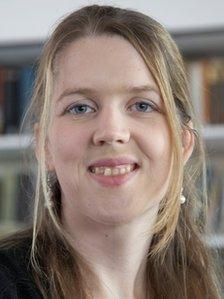Thinness in media feeds body size obsession, researchers say
- Published

Dr Lynda Boothroyd said the research gave "food for thought"
Women would be less obsessed with being thin if the media showed more pictures of larger models, Durham University research suggests.
Psychologists found that the size of models in photos exerted a powerful influence on attitudes to body size.
Study leader Dr Lynda Boothroyd said the media seemed a "powerful factor in creating body dissatisfaction".
A preference for thinness reduced significantly after the tested women were shown photos of larger models.
But after seeing similar photos of slender models, their preference for thinness increased.
Study leader Dr Lynda Boothroyd said: "There is evidence that being constantly surrounded through the media by celebrities and models who are very thin contributes to girls and women having an unhealthy attitude to their bodies.
"Although we don't yet know whether brief exposure to pictures of larger women will change women's attitudes in the long term, our findings certainly indicate that showing more 'normal' models could potentially reduce women's obsession for thinness," Dr Boothroyd added.
'Cautionary images'
More than 100 women in the study were shown images of thin and plus-size models and ordinary women in plain grey leotards.
The results supported the idea that, in Western culture, thinness was associated with good health and high status, researchers said.
"Thinner bodies are definitely in vogue and, within Western media, thinness is overwhelmingly idolised and being overweight is often stigmatised," Dr Boothroyd said.
Even so-called "cautionary" images warning of the perils of anorexia could increase preferences for thinner bodies, she added.
Rachel Cowey from South Shields, who developed anorexia at 16, said: "Within the media, being thin and attractive is linked to being successful.
"The doctors told me it was impossible to survive at the weight I was, yet the media constantly showed skinny celebrities who were apparently absolutely fine."
- Published22 June 2012
- Published20 June 2012
- Published23 March 2012